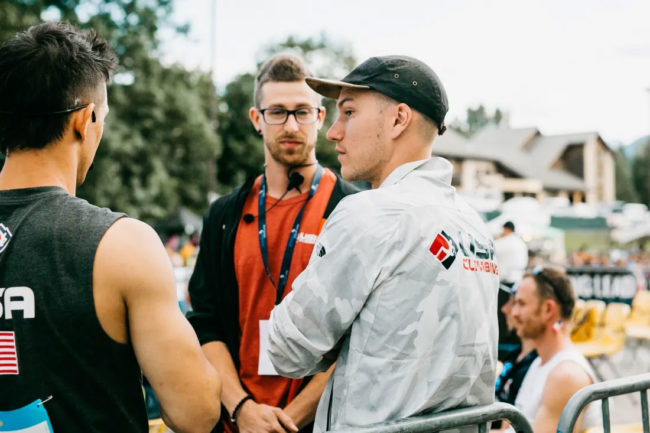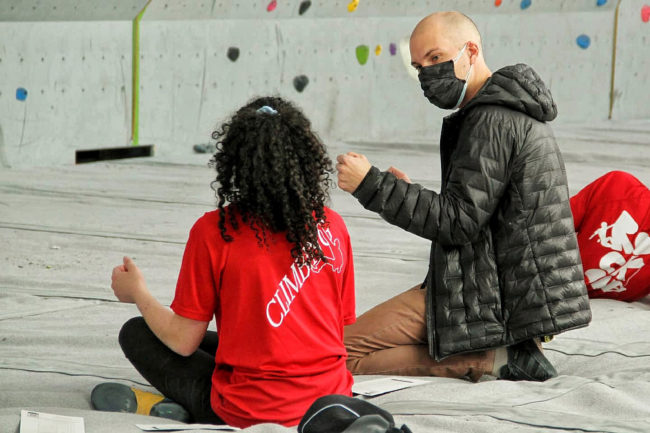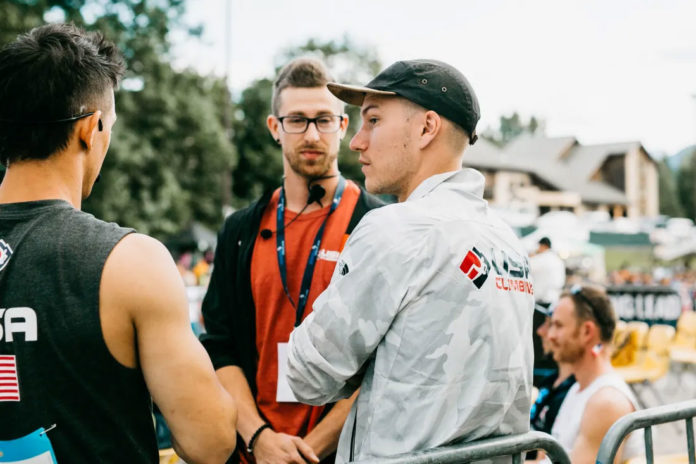
Name: Emmett Cookson
Occupation: Personal Trainer and Coach
Location: Denver, Colorado
Website: emmettcookson.com
Behind the Desk is a series that interviews people who are part of the climbing industry—those who run companies, manage staff, and carve out unique niches within the gym space. This week we’re heading out to Colorado to chat with Emmett Cookson. A lifelong athlete and sports fan, Cookson initially found success in running and competed in cross country and track at the NCAA Division 1 level. But after college, he felt burned out from running and had little interest in his coaches’ recommendations of moving into the world of marathoning. A side-hobby of climbing soon overtook the would-be career of professional running, and Cookson found himself moving around the country—from Missouri to Oklahoma and Texas and Seattle and eventually Colorado—as he established a new career as a climbing coach. The career would eventually evolve into Cookson becoming the head coach of the United States’ Paraclimbing National Team and a highly sought-after personal trainer. Since the realm of climbing personal training is still relatively new to the industry—and undoubtedly an aspect that will grow as gym climbing becomes more popular—we were interested in hearing more from Cookson about how it all works.
BURGMAN: You’ve got a fascinating backstory. Please explain how coaching and routesetting at a few gyms turned into becoming USA Climbing’s Paraclimbing National Coach and a personal trainer-for-hire.
COOKSON: I was living in Louisville [Colorado], working as a routesetter and coach at EVO. While there, I was asked to do some extra gym programming—like, an adult training program. [Paraclimbing Champion] Mo Beck signed up for my first session of adult training. She really liked my coaching style, and we realized once that training group was over that we wanted to continue working together. I offered my services, telling her that I’d love to coach her. So, I wrote training plans for her, and a lot of it was based off of things I’d seen in my past—little aspects of the running training came into play, little aspects of what John Myrick [of Team ATX] and [trainer] Justen Sjong had done with me. So, Mo did great with that, and in 2018 she came up to me and said that USA Climbing was looking for a head coach for the Para team. I eventually got that coaching role, and I believe in 2020 I made my business official as Emmett Cookson Climbing Coaching. I have clients, I do personalized training plans, and I give private lessons.
Since you have a background in both, how does the climbing industry differ from the running industry?
That’s a really great question. I would say because of running’s history and accessibility, anyone can just go out and do it. You don’t even need running shoes to go out and run. So, if you want to seriously train for running, all you really need to do is buy a pair of shoes and get a coach or read a book. There’s a ton of literature that has a lot of great science behind it. The other thing about running is that it’s so simple in its own way; it’s a grinding mindset, putting your head down and trying hard is most of what you need to learn for running. Obviously there are some skills in terms of pacing, stride, running form, posture—that’s all really important, but it’s not as skill-based of a sport as climbing, so the training is actually simple. With all that literature and science, we kind of have running training dialed in. That’s why people can start pushing the limits with two-hour marathons and stuff like that. We know how to train from every step of life for running, and now all we can do is keep improving the technology to let people go a little bit faster. Climbing, in contrast, is very complicated. I will get a client who has been climbing for a year and I have to actually watch them rock climb to see where they’re at—I can’t just look at the times they’ve clocked. It’s interesting how much more intricate climbing coaching has to be. Additionally, I think our science for climbing is all fairly new.
Relating all that more to the climbing industry, is there more that the climbing gyms could be doing to spur along the progress of training and coaching?
I think there are some things that the climbing industry is kind of limiting. Right now we’re seeing—and I say this as someone who routesets and coaches—a large push to support routesetters. We are making them into full-time positions, we are giving a lot more routesetters benefits and access to PT or health insurance, and a lot of people really idolize the routesetters. I think that’s great—the routesetters do a really important job, especially in competitions. At the same time, the industry isn’t comparably supporting its coaches. A lot of coaches end up having to routeset part-time to make a living, so a lot of them drop out of the industry. There are a lot of newer coaches in the industry—head coaches, assistant coaches, whatever their position is—and they only stay for a year or two before leaving because it’s really hard to ‘make it.’ The other crazy thing is that most head coaches are still paid hourly.
Having done a lot of these Behind the Desk interviews, it is interesting to hear so many people express the same opinion: Improving the climbing industry comes down to dollars and cents—paying more people within the industry full-time, livable wages.
It seems almost insurmountable in some ways, but I think the biggest step is recognizing the value of the people that are in the gyms from a top-down level. We need to start setting up our gyms—when we’re building new facilities—to take into account how much a [full-time] coach will cost, how many kids we can support on a team, how much we can reasonably pay. And money is always going to be the thing, in any industry. But there’s a difference between someone complaining about pay when they are making $40,000 a year and someone complaining about pay when they have consistently made about $27,000 a year—which is what I’ve made on average since I started full-time coaching, routesetting, and having a private business.
An unfortunate result of all that is that good people leave the climbing gym industry when they can’t make enough to live or raise a family. Good coaches and good routesetters and good gym staffers will only scrape by for so long before they start looking to other industries for livable income.
Right. A lot of kids may not have a very consistent coach. That can create problems with the retention rate of the climbers too. So, actually, one thing I had when I first started coaching in climbing was a goal; a goal to emulate my high school running coach—the best coach I’ve ever had—in building a legacy. He worked from the mid-1990s all the way until 2010. He built a team that consistently placed in the top four in the state because of the culture that he cultivated. So, when I became a climbing coach, I wanted to work with the same people year after year—same kids—and essentially be the next Tyson Schoene. That’s the goal.

How does being a freelance personal trainer work, exactly? I’m talking about the business relationship between you and the climbing gyms.
I’m currently working at Colorado Academy. It’s a high school in South Denver that has its own climbing facility and climbing team. I can use that facility for my private training and 10 percent of the money I earn goes to them as a facility-use fee. Prior to this, while working at other climbing gyms, I could do a private lesson through them and they’d get a cut. But there were times when all the private coaching I did had to be on the down-low. I’d tell clients, ‘No money passes hands on the premises of the climbing gym—everything has to be digital afterwards.’ There was no liability insurance that was covering me doing that private coaching. It wasn’t ideal by any means, but it was the only way that I could do private lessons, and I’m certainly not the only personal coach that gives private lessons.
As climbing gets more popular, I think we’re going to see more independent and freelance personal trainers, so it would behoove gyms to develop policies that allow for it, right?
Yes. At one point, I reached out to every gym in the Denver area and said I was looking to do private coaching through a facility. I was basically inquiring how I could work with a facility in that regard. But every single gym—except one—told me I could only be a private coach in the facility if I was on their payroll and working for them. Of course, then I asked all the gyms if they were hiring and they said no. So, it’s a rough situation where you literally need to work for a gym to do private instruction within the gym.
But that’s what I’m saying—independent instructors are probably going to give private lessons in gyms whether it’s technically allowed or not, so gyms should figure out ways to make it allowed. I mean, there has to be a solution that could work for all parties involved.
I agree. I do understand where a lot of the facilities are coming from—climbing can be dangerous, there’s liability insurance involved. But I think a lot of gyms do need to focus on this because, in my experience, private coaching—especially with adults—is getting more popular. I have a lot of athletes that I’m making private training plans for that understand the value of it. I’ll say something to them like, ‘Hey, we need to keep working on climbing skills,’ and they’ll say, ‘Could we do that privately, in-person?’ People get it when they start climbing—having someone there to critique you is much more useful than just doing an exercise on your own that someone assigned to you.
So, yeah, climbing gyms either need to hire more private coaches who are just doing that at their facilities, or they need to have measures in place to allow [independent] private coaches to use their facilities in that way. People do it all the time regardless; how many times have you turned the corner in a gym and seen someone teaching their friend how to belay using the gym top ropes? Instead of discouraging it and making people have to go behind people’s backs, let’s set up avenues for making it an actual part of our industry. It’s part of the future of climbing, after all.
Speaking of the future: It feels like 2021 was a breakout year in a lot of ways for the Paraclimbing competition circuit, with a Paraclimbing World Cup on American soil and Nationals given a really nice livestream broadcast. As head coach of the national team, how would you like to see the Paraclimbing circuit continue to grow in the U.S.?
You’re right in saying that, it really was a big year for Para. That said, I know we can do better. As I see it, the circuit needs to grow everywhere in terms of participation numbers first: We need to have six athletes in finals for each category at every international event. That means we need 15 athletes in each sport class, male and female. That means we need at least 150 athletes registered for each World Cup and for World Championships. This is actually way harder to do than it sounds right now because there are certain categories that almost never get merged and there are more that are merged two-thirds of the time. Even at U.S. Nationals in 2021, we didn’t have enough athletes registered for anyone to actually miss finals. While that’s nice in some ways—all of our competitors got experience with isolation and the onsight format—it really doesn’t behoove us to have qualifiers if that qualifying round ‘doesn’t matter,’ so to speak.
I think the sport is growing, and USA Climbing has definitely recognized that. As I’ve mentioned, USA Climbing is doing a hell of a job supporting our Para athletes as best they can. The tough part is that we still need more people taking it seriously and showing up to compete. Only when we have enough people who are hungry enough to put in the work necessary will we start seeing those 150 athletes at international competitions.
But that brings me to another point. We need more Para athletes getting sponsorships and support so that they can train and put the time in necessary to be competitive. An overwhelming majority of U.S. Paraclimbers have to work a full-time job on top of doing everything a full-time athlete needs to do to succeed—and that’s not very reasonable for lots of them. So, companies can do their part and reach out to upcoming athletes on the Para-squad and support them in their training and climbing efforts. They’re out there representing the United States just as much as someone like Ross Fulkerson or Natalia Grossman is. If any companies need any help finding athletes from the crew to support, feel free to reach out. I’ve got a list of athletes ready to go.

John Burgman is the author of High Drama, a book that chronicles the history of American competition climbing. He is a Fulbright journalism grant recipient and a former magazine editor. He holds a master’s degree from New York University and bachelor’s degree from Miami University. In addition to writing, he coaches a youth bouldering team. Follow him on Twitter @John_Burgman and Instagram @jbclimbs. Read our interview Meet John Burgman, U.S. Comp Climbing’s Top Journalist.










